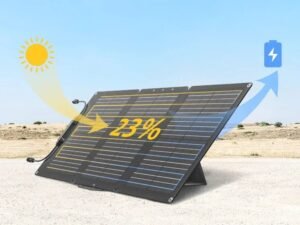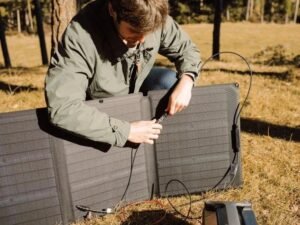The global transition to renewable energy stands at a pivotal moment, with solar power emerging as a beacon of hope in our fight against climate change. Solar panels, the remarkable technology at the heart of this revolution, represent one of humanity’s greatest achievements in harnessing nature’s boundless energy. As communities worldwide grapple with rising energy costs and environmental concerns, understanding how these devices transform sunlight into usable electricity has never been more relevant. This article delves into the fascinating world of the photovoltaic effect, breaking down complex scientific principles into practical knowledge. Whether you’re considering solar adoption or simply curious about sustainable technology, discovering how these silent energy harvesters work will illuminate the path toward a cleaner, more sustainable future. Join us as we explore the innovative technology that’s reshaping our relationship with energy and empowering individuals to participate in the renewable revolution.
The Science Behind Solar Energy and Photovoltaic Effect
Solar energy represents one of nature’s most abundant and sustainable power sources, harnessing the immense energy output of our sun. The photovoltaic effect, first discovered by French physicist Alexandre-Edmond Becquerel in 1839, forms the cornerstone of modern solar technology. This remarkable phenomenon occurs when specific materials generate an electric current upon exposure to light, fundamentally transforming how we capture and utilize solar energy.

At its core, the photovoltaic effect relies on the interaction between photons – particles of light – and semiconductor materials, primarily silicon. When sunlight strikes a solar cell, photons collide with silicon atoms, transferring their energy to electrons within the material. This energy boost excites these electrons, freeing them from their normal positions in the atomic structure. The solar cell’s design, featuring two distinct silicon layers, creates an electric field that drives these freed electrons in a specific direction, generating an electric current.
The upper silicon layer is intentionally “doped” with phosphorus to create an excess of electrons (n-type silicon), while the lower layer contains boron, creating electron deficiencies or “holes” (p-type silicon). This strategic arrangement establishes an electric field at the junction between these layers, known as the p-n junction. When electrons are excited by incoming photons, this built-in electric field propels them through an external circuit, producing usable electricity.

Several factors influence the efficiency of this energy conversion process. The silicon’s purity, the intensity and wavelength of incoming sunlight, temperature conditions, and the overall cell design all play crucial roles. Modern solar cells typically achieve efficiency rates between 15% and 20%, though laboratory conditions have produced significantly higher results. Ongoing research in materials science and cell architecture continues to push these boundaries, promising even more efficient solar energy capture in the future.
How Solar Panels Transform Sunlight into Electricity
Modern solar panels operate through a sophisticated yet elegant process that converts sunlight into usable electricity for homes and businesses. Each solar panel consists of multiple photovoltaic cells arranged in a grid pattern, protected by a durable glass covering and supported by a sturdy frame. These cells work together, combining their output to generate significant electrical power.
The conversion process begins when sunlight strikes the silicon-based photovoltaic cells. Each cell contains multiple layers of silicon treated with different materials to create positive and negative charges. As photons interact with these layers, they generate direct current (DC) electricity. This DC power flows through copper wiring to an inverter, the system’s crucial component that transforms DC into alternating current (AC) electricity – the standard form used in homes.
Advanced monitoring systems track this energy production in real-time, providing detailed insights through user-friendly interfaces. These systems enable homeowners to observe their energy generation patterns, optimize consumption, and identify potential maintenance needs. A typical residential installation might generate 20-30 kilowatt-hours of electricity on a sunny day, effectively powering essential household appliances and reducing reliance on the traditional power grid.

The entire system works seamlessly with existing electrical infrastructure, automatically switching between solar and grid power as needed. When panels produce excess electricity, this surplus can either be stored in batteries for later use or fed back into the power grid, often earning credits through net metering programs. This integration ensures consistent power availability while maximizing the benefits of solar energy production.
Solar Panel Installation: Comprehensive Process Guide
Pre-Installation Planning
Successful solar panel installation begins with thorough site assessment and planning. Professional evaluators analyze roof orientation, measuring the optimal angle for maximum sun exposure throughout the year. They conduct detailed shade analysis using advanced solar pathfinder tools to identify potential obstructions from trees, buildings, or other structures. This assessment determines the ideal panel placement for peak energy production. Energy consumption patterns are carefully evaluated through utility bill analysis and home energy audits to properly size the system. Equipment selection follows strict criteria including panel efficiency ratings, inverter compatibility, and long-term reliability factors. The planning phase also addresses local building codes, homeowners’ association requirements, and utility interconnection standards, ensuring all necessary permits are secured before installation begins.
Installation Steps
The installation process starts with mounting system preparation, where racking equipment is securely attached to roof structural members following manufacturer specifications. Installers use specialized flashing techniques to prevent water penetration at mounting points. Solar panels are carefully positioned and secured to the racking system, maintaining proper spacing for ventilation and maintenance access. Professional technicians implement industry-standard wiring practices, including proper conduit installation and grounding systems. The inverter installation follows, with careful attention to manufacturer clearance requirements and optimal placement for efficiency. Grid interconnection involves coordinating with utility providers, installing the proper metering equipment, and implementing safety disconnect systems. Throughout the process, installers follow strict safety protocols, including fall protection measures, electrical safety procedures, and equipment handling guidelines.
Solar Battery Storage: Optimizing Energy Use
Battery storage systems represent a crucial advancement in solar energy technology, enabling homeowners to maximize their renewable energy investment. These systems capture excess solar power generated during peak sunlight hours for use during evenings or cloudy days, fundamentally changing how households manage their energy consumption.
Leading manufacturers like EcoFlow have revolutionized the market with modern lithium-ion batteries, offering superior energy density, longer lifespan, and improved safety features compared to traditional lead-acid options. While lead-acid batteries typically last 5-10 years and require regular maintenance, lithium-ion solutions can function efficiently for 15-20 years with minimal upkeep.
Determining optimal storage capacity involves analyzing household energy patterns and backup power needs. A comprehensive assessment considers daily consumption, peak usage times, and critical load requirements during outages. Smart energy management systems integrate seamlessly with battery storage, automatically directing power flow based on real-time conditions. These systems monitor grid rates, weather forecasts, and consumption patterns to optimize charging and discharging cycles, potentially reducing electricity bills by up to 40%.

Integration with existing solar installations typically requires minimal modifications, as modern systems are designed for compatibility with various panel configurations. During power outages, advanced battery systems can seamlessly transition to backup power mode, maintaining essential household functions without interruption. This capability proves particularly valuable in areas prone to grid instability or natural disasters, ensuring continuous power supply for critical equipment and comfort systems.
Embracing Solar Technology for a Sustainable Future
The photovoltaic effect stands as one of science’s most transformative discoveries, enabling us to harness the sun’s boundless energy through sophisticated yet increasingly accessible solar technology. As we’ve explored, the seamless conversion of sunlight into electricity through silicon-based solar cells represents just the beginning of this renewable energy journey. The integration of advanced battery storage systems further amplifies these benefits, offering unprecedented energy independence and reliability.
Today’s solar installations, backed by smart management systems and efficient storage solutions, deliver both environmental and economic advantages that extend far beyond simple power generation. For homeowners considering solar adoption, the technology has never been more capable or cost-effective. The path to energy independence begins with a professional assessment of your property’s solar potential, evaluating factors like roof orientation, local climate patterns, and energy consumption needs. By embracing solar technology, you’re not just investing in your home’s future – you’re participating in a crucial shift toward sustainable energy that benefits both our planet and future generations.

